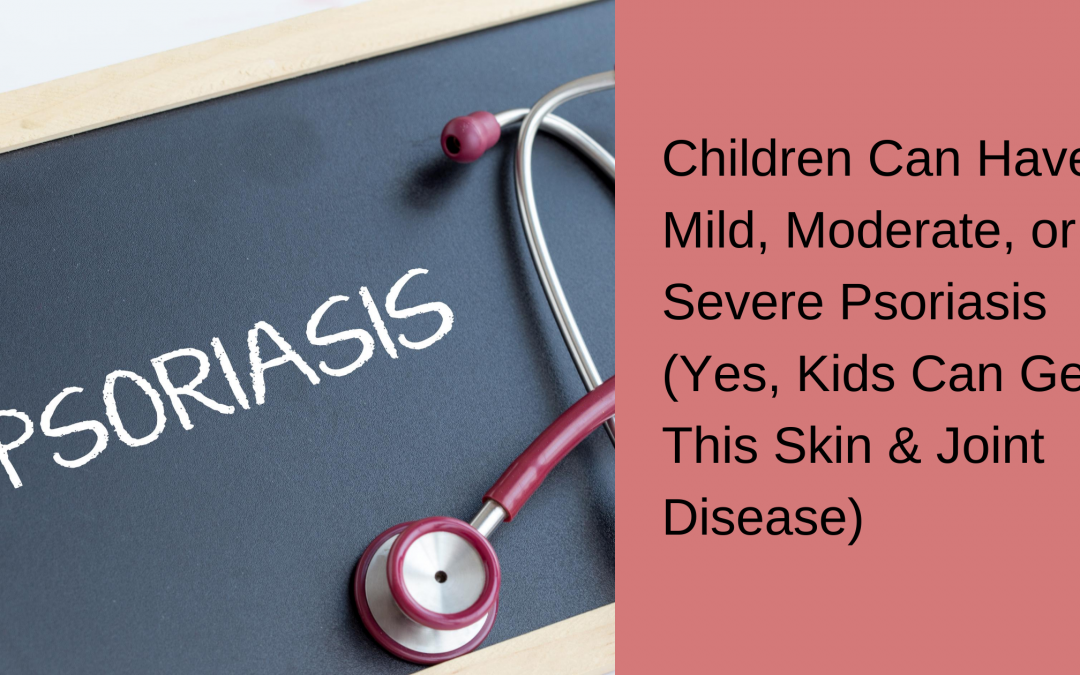Psoriasis is best known as a chronic autoimmune disease that appears on the skin. Up to 40% of people with psoriasis have symptoms before they’re 16 years old, and 10% get it before they’re 10. In fact, each year, roughly 20,000 children under 10 years of age are diagnosed with this skin & joint disease.
August is National Psoriasis Awareness Month. It is a time to learn more about how it affects children. Scientists don’t know exactly what causes psoriasis. They think the immune system and genetics play major roles in its development. Usually, something triggers psoriasis to flare up.
Studies of young people say psoriasis shows up after an infection, like strep throat. Reports are that one-third to one-half of all young people with psoriasis may have a flare-up two to six weeks after an earache, strep throat, bronchitis, tonsillitis or a respiratory infection.
The two most common versions of psoriasis among children are:
- Plaque psoriasis. Most affected kids have this type. It creates red, dry patches called plaques. But can also cause silvery scales! The plaques or scales usually show up on knees, elbows, lower back, and the scalp. They’re itchy, red, and sometimes painful. They can also bleed. Plaque psoriasis patches are smaller, thinner, and less scaly in children than in adults.
- Guttate psoriasis. This kind is also called “drop-like” psoriasis. It causes small red dots to form on the trunk, back, arms, and legs. It’s most likely to be triggered by a strep infection. Many children who get this type of psoriasis also develop plaque psoriasis. Sometimes it is misdiagnosed because it is confused with other skin diseases. Be on the lookout for symptoms which include pitting and discoloration of the nails, severe scalp scaling, diaper dermatitis or plaques similar to that of adult psoriasis on the trunk and extremities. Psoriasis in infants is uncommon, but it can occur. Only close observation can determine if an infant has the disease.
According to the National Psoriasis Foundation, “If one parent has the disease, there is about a 10 percent chance of a child contracting it. If both parents have psoriasis, the chance increases to 50 percent. No one can predict who will get psoriasis. Scientists now believe that at least 10 percent of the general population inherits one or more of the genes that create a predisposition to psoriasis. However, only 2 to 3 percent of the population develops the disease.”
No cure exists, so the goals of treatment are to slow down the disease, improve quality of life, lessen pain, and preserve the range of motion.
The American Academy of Dermatology offers these tips for managing psoriasis:
- Learn about treatment options. This will help you make informed decisions and avoid things that can make it worse. Proper treatment can prevent deformed joints and disability
- Take care of yourself. Eating a healthy diet, exercising, not smoking, and drinking very little alcohol will help.
- Be aware of your joints. If your joints feel stiff and sore, especially when you wake up, see a dermatologist. Stiff or sore joints can be the first sign of psoriatic arthritis.
- Notice your nails. If your nails begin to pull away from the nail bed or develop pitting, ridges, or a yellowish-orange color, see a dermatologist. These are signs of psoriatic arthritis.
- Pay attention to your mood. If you feel depressed, you may want to join a psoriasis support group or see a mental health professional.
- Talk with your dermatologist before you stop taking medicine for psoriasis. Immediately stopping a medicine for psoriasis can have serious consequences.
- Tell your dermatologist if you cannot afford the medicine. You may be eligible for financial assistance.
If you feel your child has psoriasis, check out this website. It will search for physicians who treat the disease in North Carolina and across the USA. https://doctor.webmd.com/find-a-doctor/condition/psoriasis/north-carolina
This post was written by Anthony M Scialis. Find him here.

